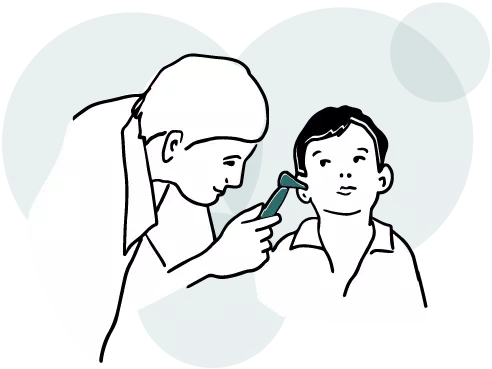

ENT Doctors May be Among the First to Spot MPS II


Recurrent ear infections2

Thick nasal and tracheal secretions2

Chronic rhinorrhea4

Progressive hearing loss2

Frequent upper respiratory tract infections2

Tracheomalacia from the deposition of glycosaminoglycans (GAGs) in the soft tissues of the throat and trachea can lead to upper airway obstruction and obstructive sleep apnea2

Chronic otitis media3
Ear, nose, and throat (ENT) disorders affect >90% of MPS patients and appear in the early stages of the disease.1 Undiagnosed patients are frequently referred to ENT specialists before diagnosis, and therefore, these specialists have an early opportunity to recognize the clinical features of an MPS disorder.1 Most MPS II patients have recurrent infections, and nearly all experience progressive hearing loss.2
Pathophysiology and clinical consequences
Changes to the soft tissues cause most of the respiratory problems associated with MPS II.3 Normal breathing is inhibited because of the skeletal manifestations of Hunter syndrome, such as stiffness of the chest wall, abnormally shaped ribs, and restricted movement of the temporomandibular joints. Breathing can also be restricted as a result of the abdominal distention caused by hepatosplenomegaly.2,3
Additionally, the enlarged tongue, hypertrophic adenoids, and tonsils, as well as skeletal changes in the jaw and neck, limit the opening of the mouth and can affect patients’ ability to chew and swallow.2,3 Upper airway obstruction is a major contributor to the morbidity and mortality of MPS II patients.3
Hearing loss is caused by both conductive and sensorineural deficits, and middle-ear effusion.2 Chronic otitis media, otosclerosis, and tympanomastoid abnormalities contribute to conductive hearing loss.2,3 Hearing loss is nearly universal in MPS II patients and can contribute to behavioral problems and learning difficulties.3
Management
Diagnosis of airway obstruction may be aided by a comprehensive evaluation of medical history, physical examination, and imaging studies.3 A first step in managing airway involvement often includes the removal of obstructions, including the tonsils and adenoids. However, due to the progressive nature of airway involvement, at a later stage it can be important to consider continuous positive airway pressure, ventilation, or tracheostomy.2,3
Routine audiological and otological evaluations should be performed in Hunter syndrome patients every 6 to 12 months.3 The use of hearing aids and myringotomy with placement of ventilating tubes may improve hearing.3
Assessment tools
Spirometry may be used to monitor progressive changes in respiratory function, although as this test requires patient cooperation it is limited in very young or severe patients.3
An overnight sleep study, conducted at a hospital or at home, can be utilized to evaluate the severity of, and effect of treatment on, obstructive sleep apnea.3 The sleep study should include assessment of the thoracic and abdominal motion, pulse oximetry to measure arterial oxygen saturation and pulse rate, and electrocardiography.5 Bronchoscopy can be used for a more thorough evaluation of respiratory involvement as it can provide an accurate observation of the dynamic obstruction that occurs during breathing.3
1. Bianchi PM et al. Ital J Pediatr. 2018;44(Suppl 2):127. 2. Martin R et al. Pediatrics. 2008;121(2):e377-e386. 3. Muenzer J et al. Pediatrics. 2009;124(6): e1228-e1239. 4. Burton BK, Giugliani R. Eur J Pediatr. 2012;171(4):631-639. 5. Scarpa M et al. Orphanet J Rare Dis. 2011;6:72.
Hunter syndrome is a
progressive genetic disease
If you suspect Hunter syndrome, refer your patient to a metabolic geneticist for an accurate diagnosis.